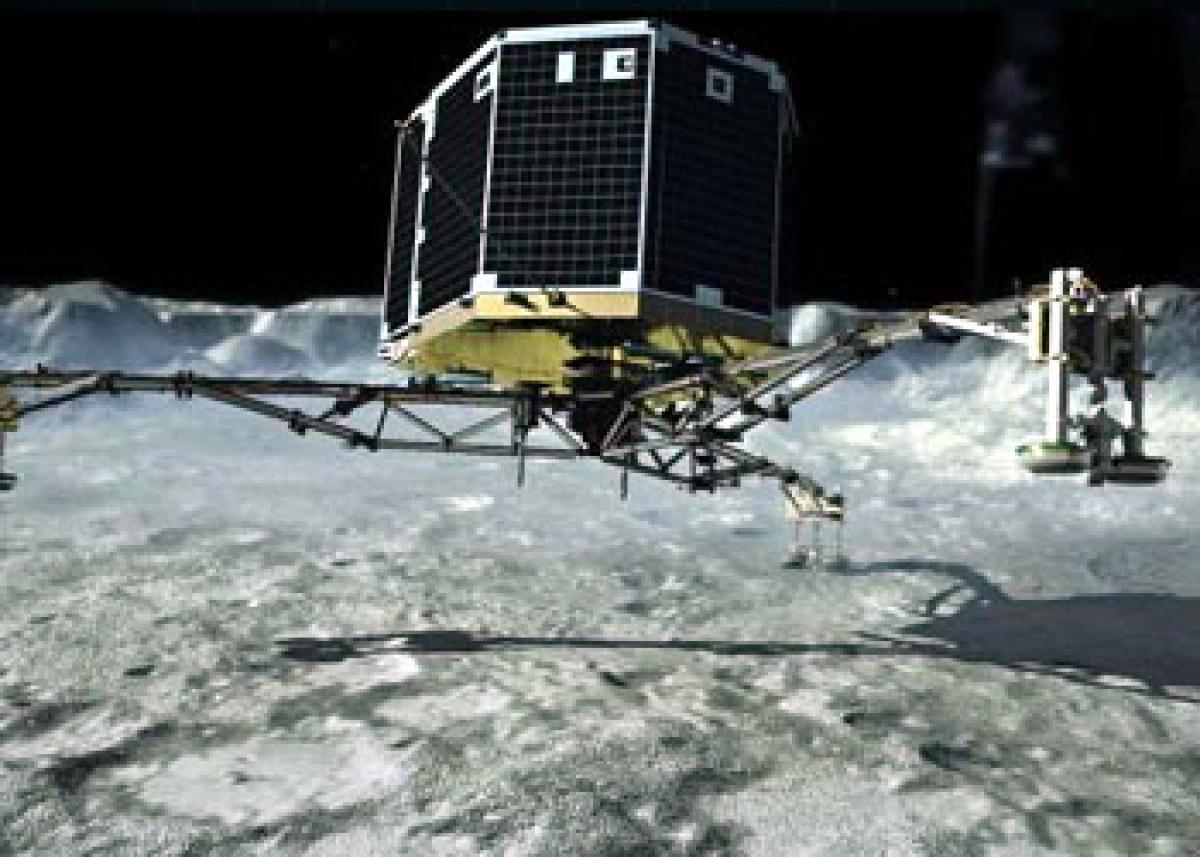Live
- GMR Airports Unveils AI-Powered Digital Twin Platform to Transform Airport Operations
- India poised to become leading maritime player: PM Modi
- Top Causes of Kidney Stones and How to Recognize Silent Symptoms
- India’s renewable energy capacity logs 14.2 pc growth at 213.7 GW
- Winter Session of Odisha Assembly adjourned sine die
- Biden calls Trump's tariff approach 'major mistake'
- After Drama Over Eknath Shinde’s Chief Minister Race, Maharashtra Cabinet Formation Faces New Tensions
- Egyptian FM, Blinken discuss recent developments in Syria
- Iran's supreme leader says Syria's developments result of US-Israeli 'plot'
- Elon Musk to Purchase $100 Million Luxury Mansion Next to Donald Trump's Mar-a-Lago, Report Reveals
Just In

Scientists gave up Friday trying to contact robot lab Philae, stubbornly silent on the surface of a comet streaking through space -- closing a captivating chapter in an historic quest.
Paris: Scientists gave up Friday trying to contact robot lab Philae, stubbornly silent on the surface of a comet streaking through space -- closing a captivating chapter in an historic quest.
"Time to say goodbye to Philae," announced the German Aerospace Center DLR, and said it "will no longer be sending any commands."
Philae's comet host is moving further and further away from the Sun and its battery-boosting rays, and by this point "there is indeed little hope to still get a signal," project manager Stephan Ulamec told AFP.
The probe was "probably" covered with comet dust, and shaded on the craggy surface of its alien home -- comet 67P/Churyomov-Gerasimenko.
Comet-orbiting mothership Rosetta will continue listening for Philae for a month or two, until it can no longer spare the energy required.
But Ulamec insisted: "to be honest and to be realistic: It's really not likely that we will hear anything any more."
The washing machine-sized probe's exploits captured the hearts and minds of thousands, hardened scientists and children alike, who followed its every move via social media and fretted when it fell silent.
Philae touched down on November 12, 2014, after a 10-year, 6.5-billion-kilometre (four-billion-mile) odyssey through space, piggybacking on Rosetta.
Placing a probe on 67P marked a breakthrough moment in the European Space Agency's mission to prod a comet for clues to the origins of life on Earth.
The months that followed yielded exciting scientific finds, and more than a little drama, as Philae intermittently phoned home between long bouts of sleep.
The lander "tweeted" about its exploits, also captured in a cartoon depicting Philae as an intrepid adventurer with a hard hat and studded boots -- Rosetta's brave little "brother".
Permanent hibernation
Philae last phoned home on July 9 last year as the comet closed in on its closest and most sunbathed point, or perihelion, reached on August 13.
Looping out again on its 6.5-year orbit, the comet by now is some 350 million km from the Sun, likely too far and much too cold for Philae to recharge and reboot.
Once out of the Sun's reach, Philae "will go into permanent hibernation," according to the DLR, which hosts the lander control centre in Cologne.
"Still listening, but I fear @Philae2014 is facing tough conditions on #67P...," Rosetta "tweeted" on Friday.
The tweet sported a drawing of a worried-looking Rosetta imagining Philae in a thought bubble -- a cute box-shaped character asleep on a mat on the ground in complete darkness between cliffs, little fingers gripping a blanket.
"... we can't prove anything, but certainly the suggestion is that the lander is either dead or broken," European Space Agency (ESA) senior science adviser Mark McCaughrean told AFP.
"In July-August, we tried very hard with Rosetta to make contact, including flying trajectories close enough and in the same direction as those where we did hear from Philae previously," but to no avail.
General consensus: 'It's over'
The absence of a signal does in itself not prove the lander is dead, as it may simply be unable to make contact with Rosetta.
But after seven months of silence, "I think the general consensus is that it's over," said McCaughrean.
Philae's landing 15 months ago was bumpy -- the lab bounced several times before ending up at an angle in shade.
But this also changed its mission specs.
If it had been out in the open, as planned, Philae would likely have overheated around April 2015, as 67P approached the Sun.
Instead, the probe entered standby mode on November 15, 2014 after sending home data from some 60 hours of comet sniffing and prodding with eight of its 10 instruments.
It awoke on June 13, and "tweeted": "Hello Earth! Can you hear me?"
After eight brief contacts, the lab fell silent again.
In January this year, ground controllers relayed commands for Philae to activate an onboard instrument in the hopes this would shake dust from its solar panels and better align the robot.
They heard nothing back.
Rosetta will continue its comet observations, said ESA, moving in closer and closer until September when it will join Philae on the surface of 67P in an endless loop around the Sun.
Just before touching down, Rosetta will try and spot Philae, allowing scientists to finally pinpoint its exact location and recalibrate some of the data it had sent home.
"We should not be too sad about what we could not achieve, but should be happy about what we could achieve," Ulamec said.
"We knew there was an end to the mission."

© 2024 Hyderabad Media House Limited/The Hans India. All rights reserved. Powered by hocalwire.com







